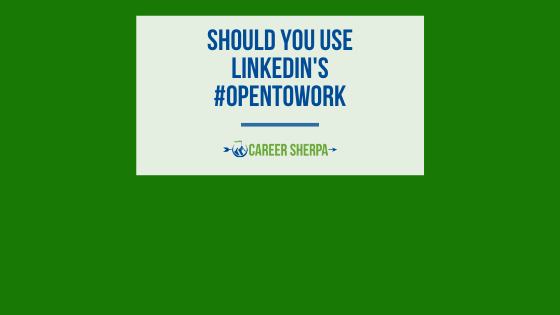Should you broadcast you are looking for work and use LinkedIn’s #OpenToWork? It’s that green banner around the LinkedIn profile photo. There are many different opinions on this. Ultimately it is your decision. Make an informed one!

Job hunting today is different than ever before. Rules and stigmas need to be broken. Especially for those that are unemployed.
So let me say, right up front, if you are unemployed and looking, consider turning on #OpenToWork (after reading the reasons below). If you are employed and looking DO NOT turn it on. You don’t want your employer to find out.
Change In Perceptions
It’s important to reiterate that this is not the 1980s when anyone who was unemployed had probably been fired. In today’s world, we all know one of our friends, family, and talented past colleagues who is looking for a new job.
The pandemic in 2020 forced millions of people to lose their jobs. Never before have we seen such a massive spike in unemployment in such a short amount of time. There was a lot of empathy towards those who lost their jobs. And there still is.
Furthermore, the loyalty agreement employers and employees held long ago no longer exists. It’s every person for themselves. Yes, you should take your job seriously, but no one is asking for a life-time of dedication. The average tenure with a company in 2020 is 4.1 years. That should tell you a lot.
The Fear and Desperation Is Real
Imagine for one second you were let go, due to no fault of your own, and found yourself jobless during an economic downturn where few companies were hiring.
How would you feel? Desperate? Maybe not at first, but after 6+ months, I bet you would. Please, let’s show some empathy.
Stop The Stigma
So to anyone who is advising job seekers NOT to use LinkedIn’s #OpenToWork banner because it appears desperate, you are wrong. Job seekers need a way to announce they are available. This is the best tool there is right now to broadcast.
Recruiters and hiring managers, especially those who have been unemployed, have stopped believing in the stigma so it’s time for us all to stop too.
Is It Unfavorable To Be Unemployed?
In Find Your Next Job More Quickly, LinkedIn asked if being unemployed positions job seekers unfavorably. Here’s the answer they got:
“Results in our data and feedback from hiring managers suggest it does not. In fact, when we surveyed hiring managers, nearly all (96%) said they would hire a candidate who was laid off due to the COVID-19 pandemic.“ -LinkedIn
LinkedIn Research On #OpenToWork
LinkedIn initially launched #OpenToWork in June, 2020. In Find Your Next Job More Quickly, to help the millions of newly unemployed.
Will #OpenToWork Increase Recruiter Outreach?
Does turning on LinkedIn’s #OpenToWork (either publicly or privately) help? LinkedIn says: “that turning on Open to Work on your LinkedIn profile increases your likelihood of getting a recruiter message by 2X. That means twice as many job opportunities.”
FYI: Recruiters who use LinkedIn’s recruiting tools can refine their search by filtering for candidates who have turned on #OpenToWork.
Your Connections Want To Help
Consider this. Anyone looking at a profile, comment or post on LinkedIn sees the profile photo and if it’s there, the #OpenToWork green banner. That means that everyone will know the person is available. In fact, in the early days LinkedIn research reported recent survey 84% of people said they would be willing to help someone in their professional network who has lost their job due to COVID-19 find a new role!
Referrals Count A Lot
Everyone knows how powerful networking is. But it can be difficult to explain exactly how it works. It’s a little unscientific.
What we know is that referrals can open doors. You never know who may be able to refer you for a job or who people know. LinkedIn reported that “Members were 4x more likely to get hired when they leveraged their networks on LinkedIn while job seeking.”
The Banner Doesn’t Take Away, It Adds
Adding the #OpenToWork banner doesn’t appear in the headline or take up space from your profile. It adds important information to your profile picture. And your profile picture shows up in search results. So no harm done.
It’s Not Enough To Just Use #OpenToWork?
Setting your profile to show you are publicly #OpenToWork isn’t enough. You must have a robust LinkedIn profile. It must show you’re qualified for the roles you target. In other words, your profile has to show the skills, knowledge and experience recruiters and hiring managers need. And you control what’s in your LinkedIn profile.
That means you need to invest time in these four areas of your LinkedIn profile:
- Headline
- About
- Experience
- Skills
And extra bonus points if you make it a point to post and comment regularly on LinkedIn.
Test It For Yourself
If you still feel hesitant about publicly sharing your #OpenToWork banner, test it. Turn it on for 2-3 weeks and see if you get more profile views. (You should note your analytics before you turn on the banner so you can compare your numbers.)
To see your profile analytics, go to your profile and scroll down just past the top section. Write down these three numbers: Profile views, Post Impressions, Search Appearances.

Post You Are Available
And for those that are brave enough, here’s one more thing you can do to let everyone know you are available for new work – post an announcement on LinkedIn.
Positively express you are looking for a new job and explain specifically what jobs you are looking for and what types of companies you would like to work for. If you want to include skills, knowledge and expertise, that’s a good idea too!
Here’s My Final Point
If your LinkedIn profile clearly and thoroughly explains your qualifications, then you do not appear desperate. You are just drawing extra attention to your strong credentials when you use LinkedIn’s #OpenToWork green banner.
Go ahead, maximize your profile. First, record the number of people who view your profile and number of InMail messages or contacts you receive for job opportunities. Next, turn on the #OpenToWork banner publicly and record the new numbers after a couple of weeks. You have nothing to lose in experimenting with #OpenToWork.
Here are LinkedIn’s instructions on how to turn on #OpenToWork

Hannah Morgan speaks and writes about job search and career strategies. She founded CareerSherpa.net to educate professionals on how to maneuver through today’s job search process. Hannah was nominated as a LinkedIn Top Voice in Job Search and Careers and is a regular contributor to US News & World Report. She has been quoted by media outlets, including Forbes, USA Today, Money Magazine, Huffington Post, as well as many other publications. She is also author of The Infographic Resume and co-author of Social Networking for Business Success.
